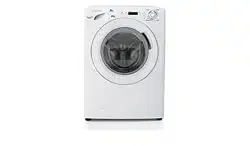Loading ...
Loading ...
Loading ...

DE
IT
PT
ES
EN
13.05 - 43005089
Dieses Gerät ist entsprechend der europäischen Richtlinie 2012/19/EU als elektrisches / elektronisches
Altgerät (WEEE) gekennzeichnet. Elektrische und elektronische Altgeräte enthalten vielfach noch
wertvolle Materialien. Sie enthalten aber auch schädliche Stoffe, die für ihre Funktion und Sicherheit
notwendig waren. Im Restmüll oder bei falscher Behandlung können diese der menschlichen
Gesundheit und der Umwelt schaden. Es ist daher sehr wichtig, dass elektrische und elektronische
Altgeräte (WEEE) einer speziellen Verwertung zugeführt werden, damit die schädlichen
Stoffe ordnungsgemäß entfernt und entsorgt werden bzw. wertvolle Rohstoffe der Wiederverwertung
zugeführt werden können. Sie können mit der Beachtung der folgenden simplen Hinweise
einen wichtigen Beitrag dazu leisten, dass elektrische und elektronische Altgeräte (WEEE) der
menschlichen Gesundheit und der Umwelt nicht schaden:
- Elektrische- und elektronische Altgeräte (WEEE) sollten keinesfalls wie Rest- oder Haushaltsmüll
behandelt werden.
- Nutzen Sie stattdessen die an Ihrem Wohnort eingerichteten kommunalen oder gewerblichen
Sammelstellen zur Rückgabe und Verwertung elektrischer und elektronischer Altgeräte
(WEEE). Informieren Sie sich, ob ggf. in Ihrem Land bzw. Ihrer Region für große/sperrige
elektrische und elektronische Altgeräte (WEEE) eine Abholung angeboten wird. Sorgen Sie in
jedem Falle dafür, dass Ihr Altgerät bis zum Abtransport kindersicher aufbewahrt wird.
In einigen Ländern sind Händler unterbestimmten Voraussetzungen beim Geräteneukauf
Funktion entspricht.
da Apparecchiature Elettriche ed Elettroniche (RAEE). I RAEE contengono sia sostanze inquinanti
(che possono cioè avere un impatto negativo anche molto pesante sull’ambiente) sia materie prime
(che possono essere riutilizzate). E’ perciò necessario sottoporre i RAEE ad apposite operazioni
di trattamento, per rimuovere e smaltire in modo sicuro le sostanze inquinanti ed estrarre e riciclare
le materie prime. Ogni cittadino può giocare un ruolo decisivo nell’assicurare che i RAEE non
diventino un problema ambientale; basta seguire qualche semplice regola:
- i RAEE non vanno mai buttati nella spazzatura indifferenziata;
- i RAEE devono essere consegnati ai Centri di Raccolta (chiamati anche isole ecologiche, riciclerie,
piattaforme ecologiche …) allestiti dai Comuni o dalle Società di igiene urbana; in molte località
viene anche effettuato il servizio di ritiro a domicilio dei RAEE ingombranti.
In molte nazioni, quando si acquista una nuova apparecchiatura, si può consegnare il RAEE al
negoziante, che è tenuto a ritirarlo gratuitamente (ritiro “uno contro uno”) a patto che il nuovo
reciclar todos os materiais. Os consumidores podem desempenhar um papel importante no
sentido de garantir que os REEE não se tornem num problema ambiental. Para isso é essencial
- REEE não devem ser tratadas como lixo doméstico.
ou recolhido pelo retalhista sem custos para o consumidor, desde que o equipamento seja de
um género semelhante.
Este dispositivo tiene el distintivo de la directiva europea 2012/19/UE sobre Residuos de Aparatos
Eléctricos y Electrónicos (RAEE). Los RAEE contienen tanto sustancias contaminantes (que pueden
extraer y eliminar, de forma adecuada, todos los agentes contaminantes. Igual de importante es
recuperar y reciclar todo el material posible. La gente puede desempeñar una función importante
a la hora de asegurarse de que los RAEE no se convierten en un problema medioambiental; es
- Los RAEE no han de tratarse como residuos domésticos.
- Los RAEE han de depositarse en los puntos de recogida habilitados para ello que gestiona el
recogida a domicilio de los RAEE de mayor volumen.
al vendedor, quien lo recoge de forma gratuita (un dispositivo antiguo por cada dispositivo adquirido)
siempre que el equipo entregado sea similar y disponga de las mismas funciones que el adquirido.
This appliance is marked according to the European directive 2012/19/EU on Waste Electrical
and Electronic Equipment (WEEE). WEEE contains both polluting substances (which can cause
negative consequences for the environment) and basic components (which can be re-used).
properly all pollutants, and recover and recycle all materials. Individuals can play an important
role in ensuring that WEEE does not become an environmental issue; it is essential to follow
some basic rules:
- WEEE should not be treated as household waste;
- WEEE should be handed over to the relevant collection points managed by the municipality or
by registered companies. In many countries, for large WEEE, home collection could be present.
In many countries, when you buy a new appliance, the old one may be returned to the retailer
who has to collect it free of charge on a one-to-one basis, as long as the equipment is of equiva-
lent type and has the same functions as the supplied equipment.
15.07 - 43011368
apparecchio sia dello stesso tipo e svolga le stesse funzioni di quello reso.
